STAT3 and STAT5: Understanding Roles in Breast Cancer Development
VerifiedAdded on 2023/06/10
|16
|4672
|486
Report
AI Summary
This report reviews a research paper focused on the roles of STAT3 and STAT5 transcription factors in breast cancer, evaluating their potential as diagnostic and prognostic tools. The research builds upon previous studies, highlighting the significance of STAT3 and STAT5 in mammary cell development and breast cancer pathogenesis. Various methods, including immunohistochemistry and gene expression analysis, were employed to ascertain the characteristics of tumors and the specificity of STAT5 and STAT3. The co-activation of these STATs significantly affects sensitivity and proliferation, with STAT5 playing a dominant role in modulating the effects of STAT3. The inappropriate activation of STATs is common in breast cancer, making them vital targets for diagnostic and therapeutic interventions. The report also touches upon the potential dangers of using prolactin in research due to its association with increased breast cancer risk.
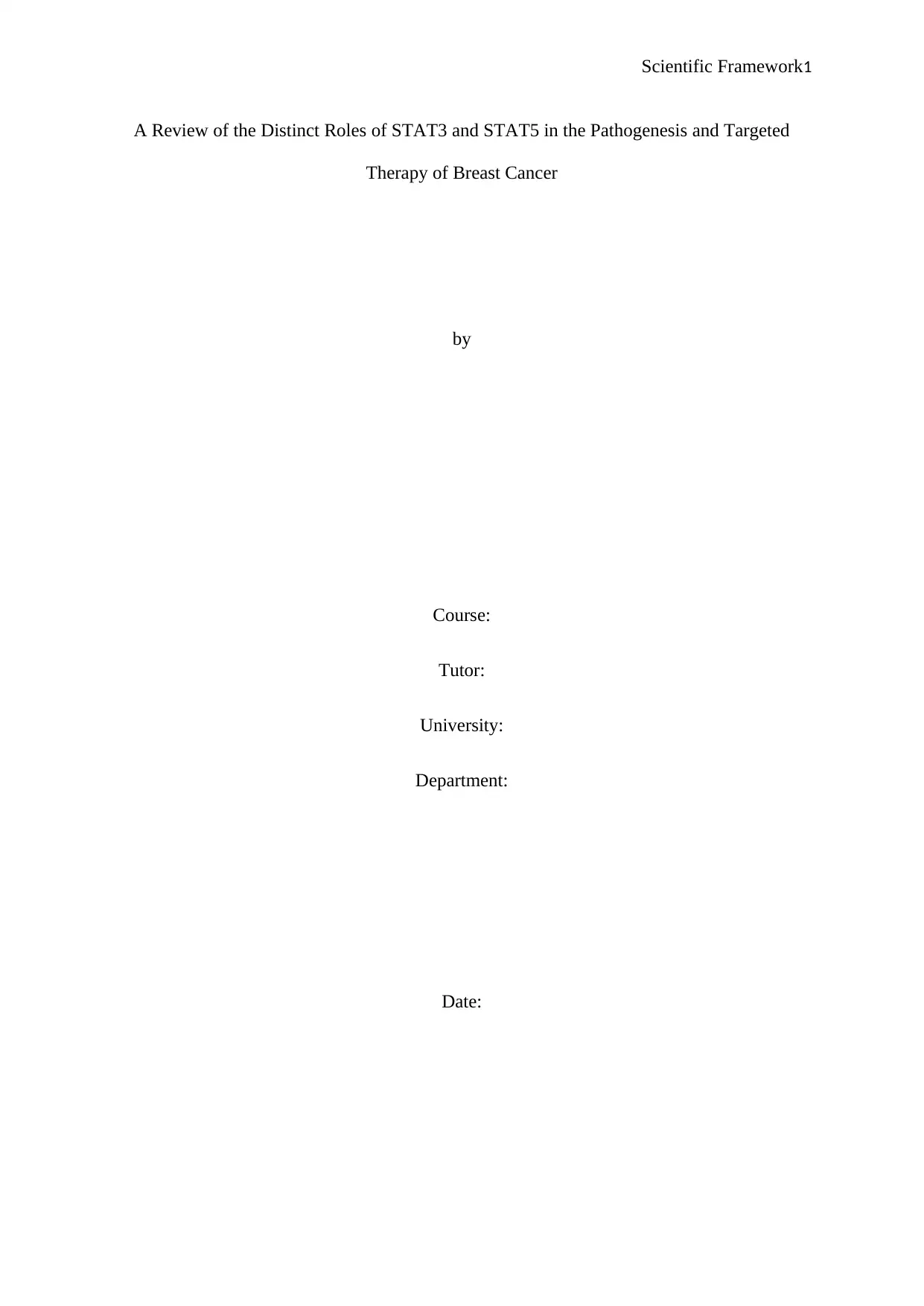
Scientific Framework1
A Review of the Distinct Roles of STAT3 and STAT5 in the Pathogenesis and Targeted
Therapy of Breast Cancer
by
Course:
Tutor:
University:
Department:
Date:
A Review of the Distinct Roles of STAT3 and STAT5 in the Pathogenesis and Targeted
Therapy of Breast Cancer
by
Course:
Tutor:
University:
Department:
Date:
Paraphrase This Document
Need a fresh take? Get an instant paraphrase of this document with our AI Paraphraser
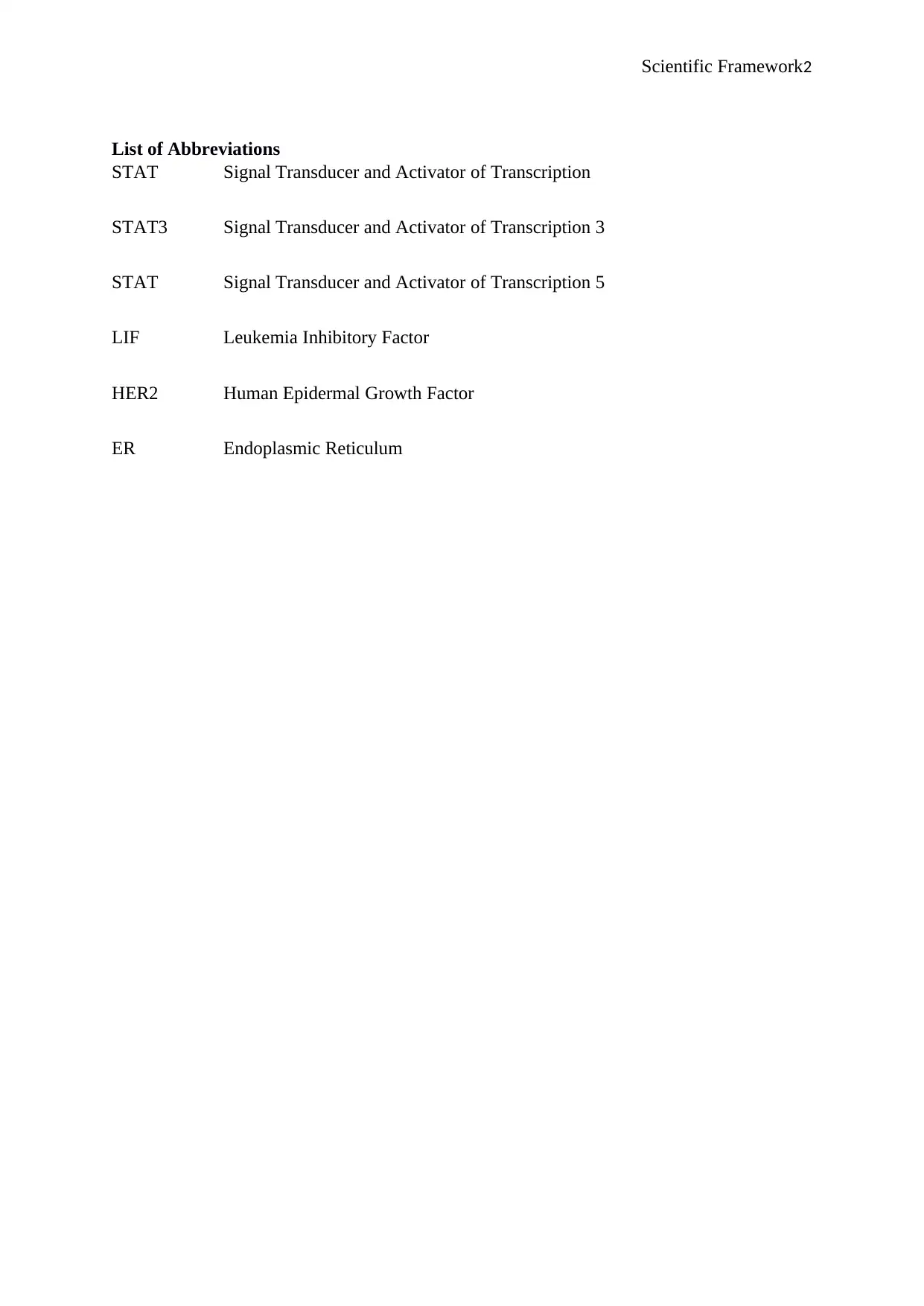
Scientific Framework2
List of Abbreviations
STAT Signal Transducer and Activator of Transcription
STAT3 Signal Transducer and Activator of Transcription 3
STAT Signal Transducer and Activator of Transcription 5
LIF Leukemia Inhibitory Factor
HER2 Human Epidermal Growth Factor
ER Endoplasmic Reticulum
List of Abbreviations
STAT Signal Transducer and Activator of Transcription
STAT3 Signal Transducer and Activator of Transcription 3
STAT Signal Transducer and Activator of Transcription 5
LIF Leukemia Inhibitory Factor
HER2 Human Epidermal Growth Factor
ER Endoplasmic Reticulum
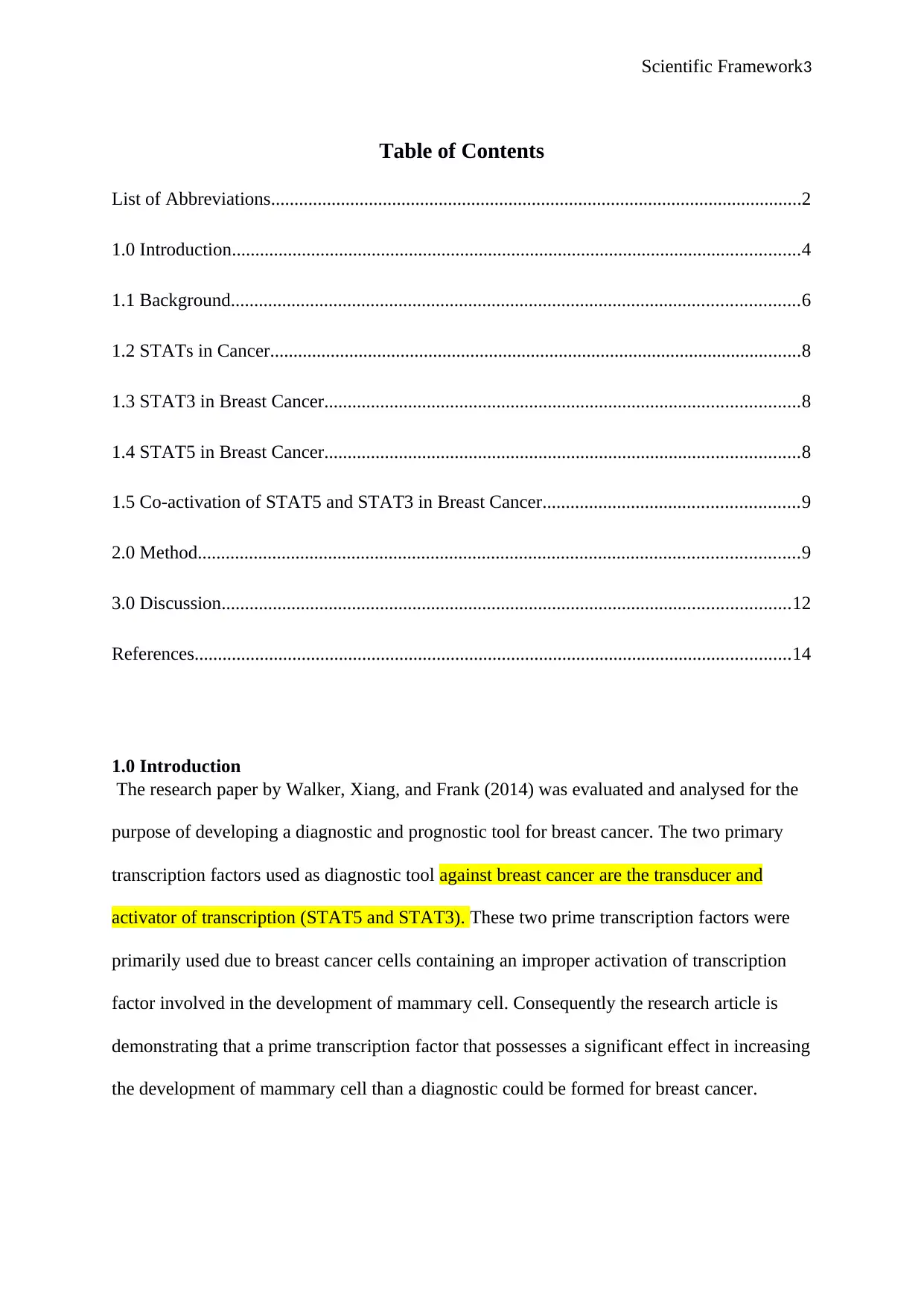
Scientific Framework3
Table of Contents
List of Abbreviations..................................................................................................................2
1.0 Introduction..........................................................................................................................4
1.1 Background..........................................................................................................................6
1.2 STATs in Cancer..................................................................................................................8
1.3 STAT3 in Breast Cancer......................................................................................................8
1.4 STAT5 in Breast Cancer......................................................................................................8
1.5 Co-activation of STAT5 and STAT3 in Breast Cancer.......................................................9
2.0 Method.................................................................................................................................9
3.0 Discussion..........................................................................................................................12
References................................................................................................................................14
1.0 Introduction
The research paper by Walker, Xiang, and Frank (2014) was evaluated and analysed for the
purpose of developing a diagnostic and prognostic tool for breast cancer. The two primary
transcription factors used as diagnostic tool against breast cancer are the transducer and
activator of transcription (STAT5 and STAT3). These two prime transcription factors were
primarily used due to breast cancer cells containing an improper activation of transcription
factor involved in the development of mammary cell. Consequently the research article is
demonstrating that a prime transcription factor that possesses a significant effect in increasing
the development of mammary cell than a diagnostic could be formed for breast cancer.
Table of Contents
List of Abbreviations..................................................................................................................2
1.0 Introduction..........................................................................................................................4
1.1 Background..........................................................................................................................6
1.2 STATs in Cancer..................................................................................................................8
1.3 STAT3 in Breast Cancer......................................................................................................8
1.4 STAT5 in Breast Cancer......................................................................................................8
1.5 Co-activation of STAT5 and STAT3 in Breast Cancer.......................................................9
2.0 Method.................................................................................................................................9
3.0 Discussion..........................................................................................................................12
References................................................................................................................................14
1.0 Introduction
The research paper by Walker, Xiang, and Frank (2014) was evaluated and analysed for the
purpose of developing a diagnostic and prognostic tool for breast cancer. The two primary
transcription factors used as diagnostic tool against breast cancer are the transducer and
activator of transcription (STAT5 and STAT3). These two prime transcription factors were
primarily used due to breast cancer cells containing an improper activation of transcription
factor involved in the development of mammary cell. Consequently the research article is
demonstrating that a prime transcription factor that possesses a significant effect in increasing
the development of mammary cell than a diagnostic could be formed for breast cancer.
⊘ This is a preview!⊘
Do you want full access?
Subscribe today to unlock all pages.

Trusted by 1+ million students worldwide
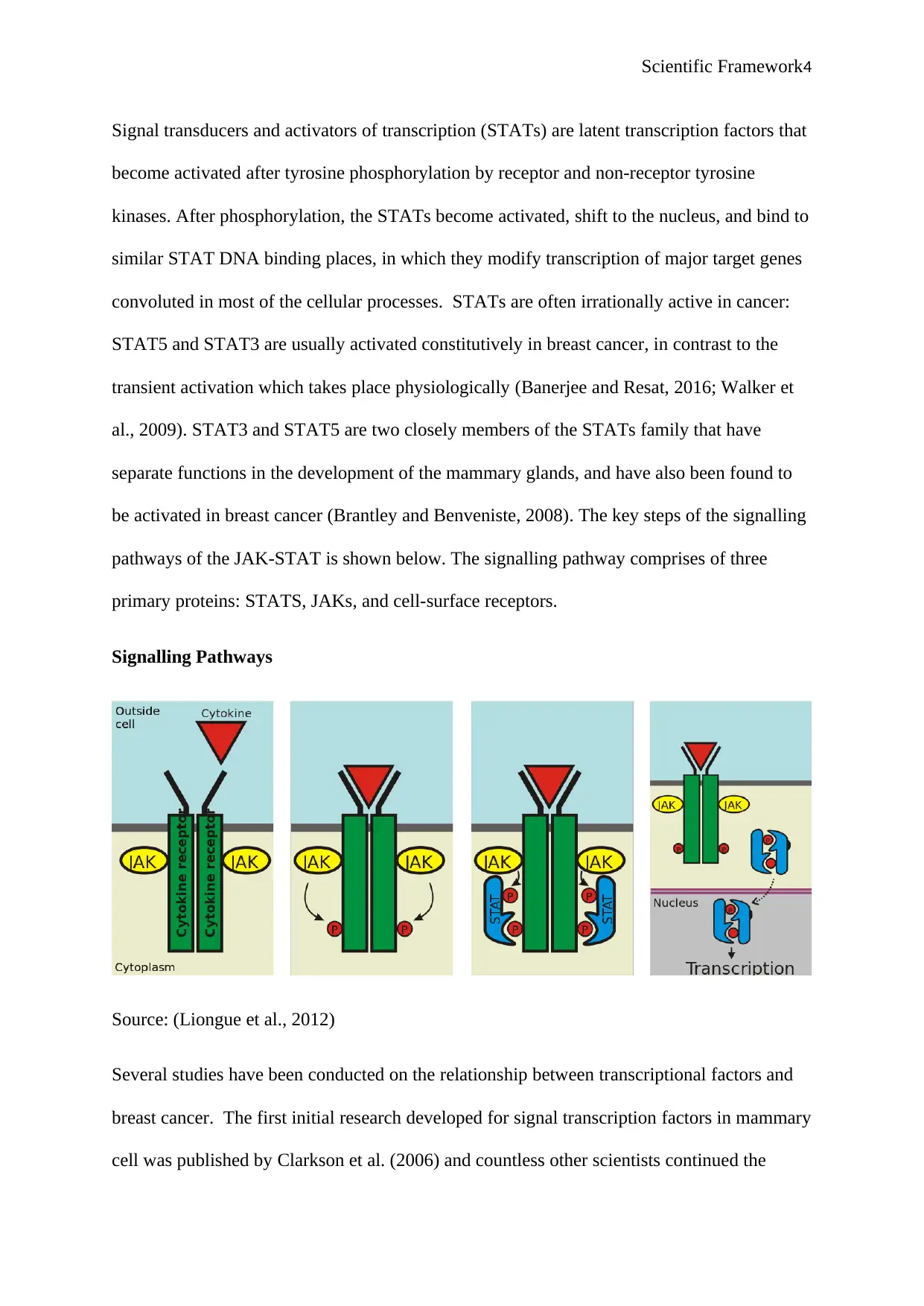
Scientific Framework4
Signal transducers and activators of transcription (STATs) are latent transcription factors that
become activated after tyrosine phosphorylation by receptor and non-receptor tyrosine
kinases. After phosphorylation, the STATs become activated, shift to the nucleus, and bind to
similar STAT DNA binding places, in which they modify transcription of major target genes
convoluted in most of the cellular processes. STATs are often irrationally active in cancer:
STAT5 and STAT3 are usually activated constitutively in breast cancer, in contrast to the
transient activation which takes place physiologically (Banerjee and Resat, 2016; Walker et
al., 2009). STAT3 and STAT5 are two closely members of the STATs family that have
separate functions in the development of the mammary glands, and have also been found to
be activated in breast cancer (Brantley and Benveniste, 2008). The key steps of the signalling
pathways of the JAK-STAT is shown below. The signalling pathway comprises of three
primary proteins: STATS, JAKs, and cell-surface receptors.
Signalling Pathways
Source: (Liongue et al., 2012)
Several studies have been conducted on the relationship between transcriptional factors and
breast cancer. The first initial research developed for signal transcription factors in mammary
cell was published by Clarkson et al. (2006) and countless other scientists continued the
Signal transducers and activators of transcription (STATs) are latent transcription factors that
become activated after tyrosine phosphorylation by receptor and non-receptor tyrosine
kinases. After phosphorylation, the STATs become activated, shift to the nucleus, and bind to
similar STAT DNA binding places, in which they modify transcription of major target genes
convoluted in most of the cellular processes. STATs are often irrationally active in cancer:
STAT5 and STAT3 are usually activated constitutively in breast cancer, in contrast to the
transient activation which takes place physiologically (Banerjee and Resat, 2016; Walker et
al., 2009). STAT3 and STAT5 are two closely members of the STATs family that have
separate functions in the development of the mammary glands, and have also been found to
be activated in breast cancer (Brantley and Benveniste, 2008). The key steps of the signalling
pathways of the JAK-STAT is shown below. The signalling pathway comprises of three
primary proteins: STATS, JAKs, and cell-surface receptors.
Signalling Pathways
Source: (Liongue et al., 2012)
Several studies have been conducted on the relationship between transcriptional factors and
breast cancer. The first initial research developed for signal transcription factors in mammary
cell was published by Clarkson et al. (2006) and countless other scientists continued the
Paraphrase This Document
Need a fresh take? Get an instant paraphrase of this document with our AI Paraphraser

Scientific Framework5
research to enhance the study and to establish a better therapy for cancer (Yu, Pardoll, and
Jove, 2009; Walker et al., 2009; Creamer et al., 2010). There are minor contrasts between the
first initial research (Clarkson et al. (2006) and the research by Walker et al. (2009). The
existing difference is that the initial research only focus on the development of mammary
epithelial cells using STAT3, STAT5 and Prolactin and Leukemia inhibitory factor (LIF),
whereas, the second research focuses on diagnostic and prognostic in mammary gland using
STAT3 and STAT5. The research of Sarah R. Walker et al. (2009) is building on the previous
work carried out by Richard W.E Clarkson et al. (2006) but aiming at finding a diagnostic in
breast cancer, using a different approach in methodology in order to improve the progress.
Clarkson et al. (2006) found out that specific activation of STAT3 and STAT5 alone is
enough to prompt and subdue apoptosis respectively through the inducement of specific
genes in mammary epithelial cells. On the other hand, Walker et al. (2009) found out that
STAT5 can modify the impacts of STAT3 beginning from the state of gene expression to
cellular phenotype. Walker et al. (2013) conducted a study to ascertain the method by which
BCL6 transcription is regulated by the oncogenic transcription factors. The authors found out
that STAT3 raises BCL6 expression and improves the recruitment of RNA polymerase II,
whereas STAT5 represses expression of BCL6 below basal levels and lowers the association
of RNA polymerase II.
Several methods were used by Walker et al. (2014) to provide evidence to their study and
hypothesis. These methods included immunohistochemistry, gene expression array analysis,
cell lines and stimulations, immunoblots, reports gene assays, reverse transcription PCR,
short interfering RNA, viral production and infections, viability assays, and lastly caspace
activation assay. These tests were carried out to ascertain the characteristics of tumours
showing activation in protein, and also to test the specificity of STAT5 and STAT3.
research to enhance the study and to establish a better therapy for cancer (Yu, Pardoll, and
Jove, 2009; Walker et al., 2009; Creamer et al., 2010). There are minor contrasts between the
first initial research (Clarkson et al. (2006) and the research by Walker et al. (2009). The
existing difference is that the initial research only focus on the development of mammary
epithelial cells using STAT3, STAT5 and Prolactin and Leukemia inhibitory factor (LIF),
whereas, the second research focuses on diagnostic and prognostic in mammary gland using
STAT3 and STAT5. The research of Sarah R. Walker et al. (2009) is building on the previous
work carried out by Richard W.E Clarkson et al. (2006) but aiming at finding a diagnostic in
breast cancer, using a different approach in methodology in order to improve the progress.
Clarkson et al. (2006) found out that specific activation of STAT3 and STAT5 alone is
enough to prompt and subdue apoptosis respectively through the inducement of specific
genes in mammary epithelial cells. On the other hand, Walker et al. (2009) found out that
STAT5 can modify the impacts of STAT3 beginning from the state of gene expression to
cellular phenotype. Walker et al. (2013) conducted a study to ascertain the method by which
BCL6 transcription is regulated by the oncogenic transcription factors. The authors found out
that STAT3 raises BCL6 expression and improves the recruitment of RNA polymerase II,
whereas STAT5 represses expression of BCL6 below basal levels and lowers the association
of RNA polymerase II.
Several methods were used by Walker et al. (2014) to provide evidence to their study and
hypothesis. These methods included immunohistochemistry, gene expression array analysis,
cell lines and stimulations, immunoblots, reports gene assays, reverse transcription PCR,
short interfering RNA, viral production and infections, viability assays, and lastly caspace
activation assay. These tests were carried out to ascertain the characteristics of tumours
showing activation in protein, and also to test the specificity of STAT5 and STAT3.
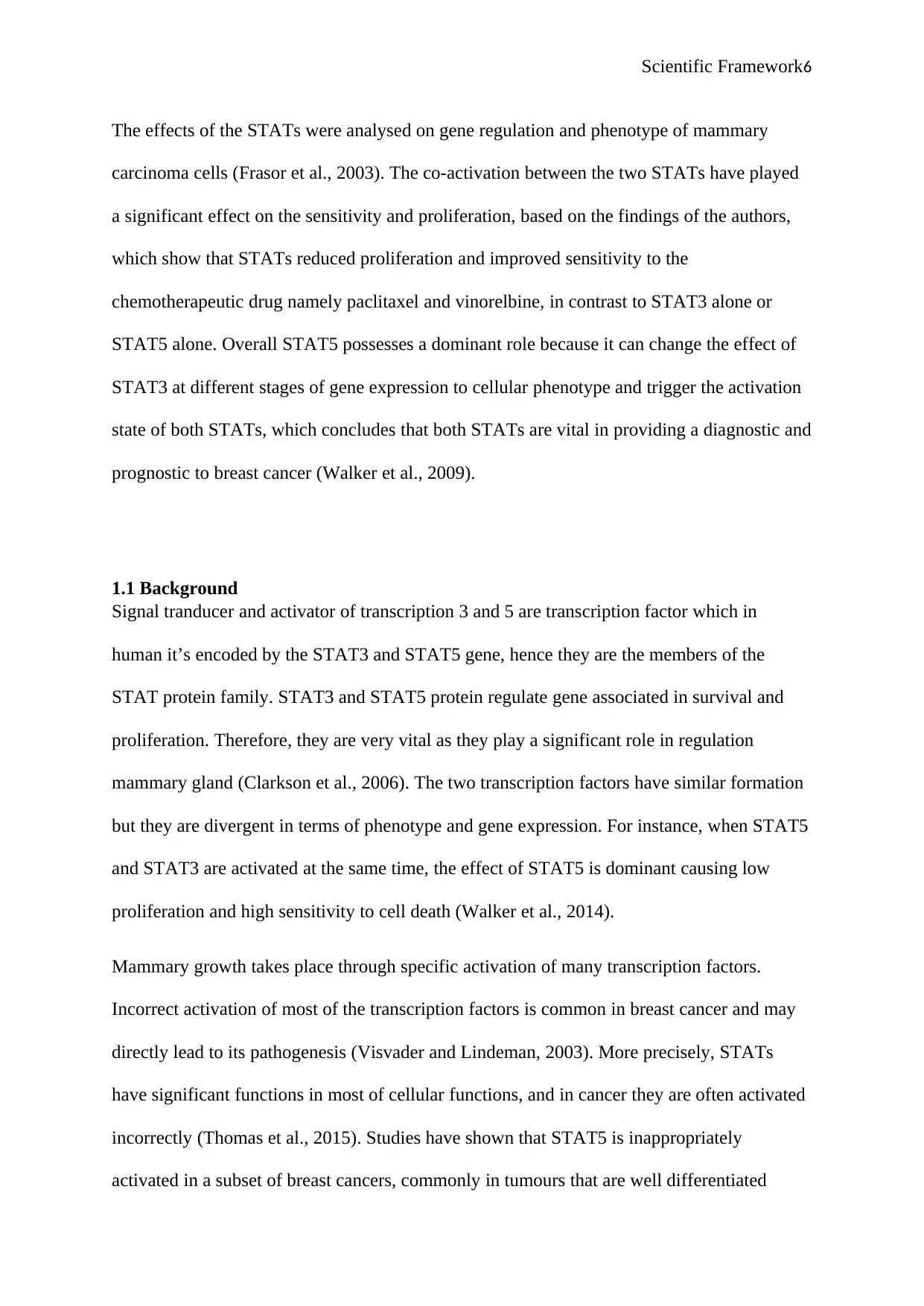
Scientific Framework6
The effects of the STATs were analysed on gene regulation and phenotype of mammary
carcinoma cells (Frasor et al., 2003). The co-activation between the two STATs have played
a significant effect on the sensitivity and proliferation, based on the findings of the authors,
which show that STATs reduced proliferation and improved sensitivity to the
chemotherapeutic drug namely paclitaxel and vinorelbine, in contrast to STAT3 alone or
STAT5 alone. Overall STAT5 possesses a dominant role because it can change the effect of
STAT3 at different stages of gene expression to cellular phenotype and trigger the activation
state of both STATs, which concludes that both STATs are vital in providing a diagnostic and
prognostic to breast cancer (Walker et al., 2009).
1.1 Background
Signal tranducer and activator of transcription 3 and 5 are transcription factor which in
human it’s encoded by the STAT3 and STAT5 gene, hence they are the members of the
STAT protein family. STAT3 and STAT5 protein regulate gene associated in survival and
proliferation. Therefore, they are very vital as they play a significant role in regulation
mammary gland (Clarkson et al., 2006). The two transcription factors have similar formation
but they are divergent in terms of phenotype and gene expression. For instance, when STAT5
and STAT3 are activated at the same time, the effect of STAT5 is dominant causing low
proliferation and high sensitivity to cell death (Walker et al., 2014).
Mammary growth takes place through specific activation of many transcription factors.
Incorrect activation of most of the transcription factors is common in breast cancer and may
directly lead to its pathogenesis (Visvader and Lindeman, 2003). More precisely, STATs
have significant functions in most of cellular functions, and in cancer they are often activated
incorrectly (Thomas et al., 2015). Studies have shown that STAT5 is inappropriately
activated in a subset of breast cancers, commonly in tumours that are well differentiated
The effects of the STATs were analysed on gene regulation and phenotype of mammary
carcinoma cells (Frasor et al., 2003). The co-activation between the two STATs have played
a significant effect on the sensitivity and proliferation, based on the findings of the authors,
which show that STATs reduced proliferation and improved sensitivity to the
chemotherapeutic drug namely paclitaxel and vinorelbine, in contrast to STAT3 alone or
STAT5 alone. Overall STAT5 possesses a dominant role because it can change the effect of
STAT3 at different stages of gene expression to cellular phenotype and trigger the activation
state of both STATs, which concludes that both STATs are vital in providing a diagnostic and
prognostic to breast cancer (Walker et al., 2009).
1.1 Background
Signal tranducer and activator of transcription 3 and 5 are transcription factor which in
human it’s encoded by the STAT3 and STAT5 gene, hence they are the members of the
STAT protein family. STAT3 and STAT5 protein regulate gene associated in survival and
proliferation. Therefore, they are very vital as they play a significant role in regulation
mammary gland (Clarkson et al., 2006). The two transcription factors have similar formation
but they are divergent in terms of phenotype and gene expression. For instance, when STAT5
and STAT3 are activated at the same time, the effect of STAT5 is dominant causing low
proliferation and high sensitivity to cell death (Walker et al., 2014).
Mammary growth takes place through specific activation of many transcription factors.
Incorrect activation of most of the transcription factors is common in breast cancer and may
directly lead to its pathogenesis (Visvader and Lindeman, 2003). More precisely, STATs
have significant functions in most of cellular functions, and in cancer they are often activated
incorrectly (Thomas et al., 2015). Studies have shown that STAT5 is inappropriately
activated in a subset of breast cancers, commonly in tumours that are well differentiated
⊘ This is a preview!⊘
Do you want full access?
Subscribe today to unlock all pages.

Trusted by 1+ million students worldwide
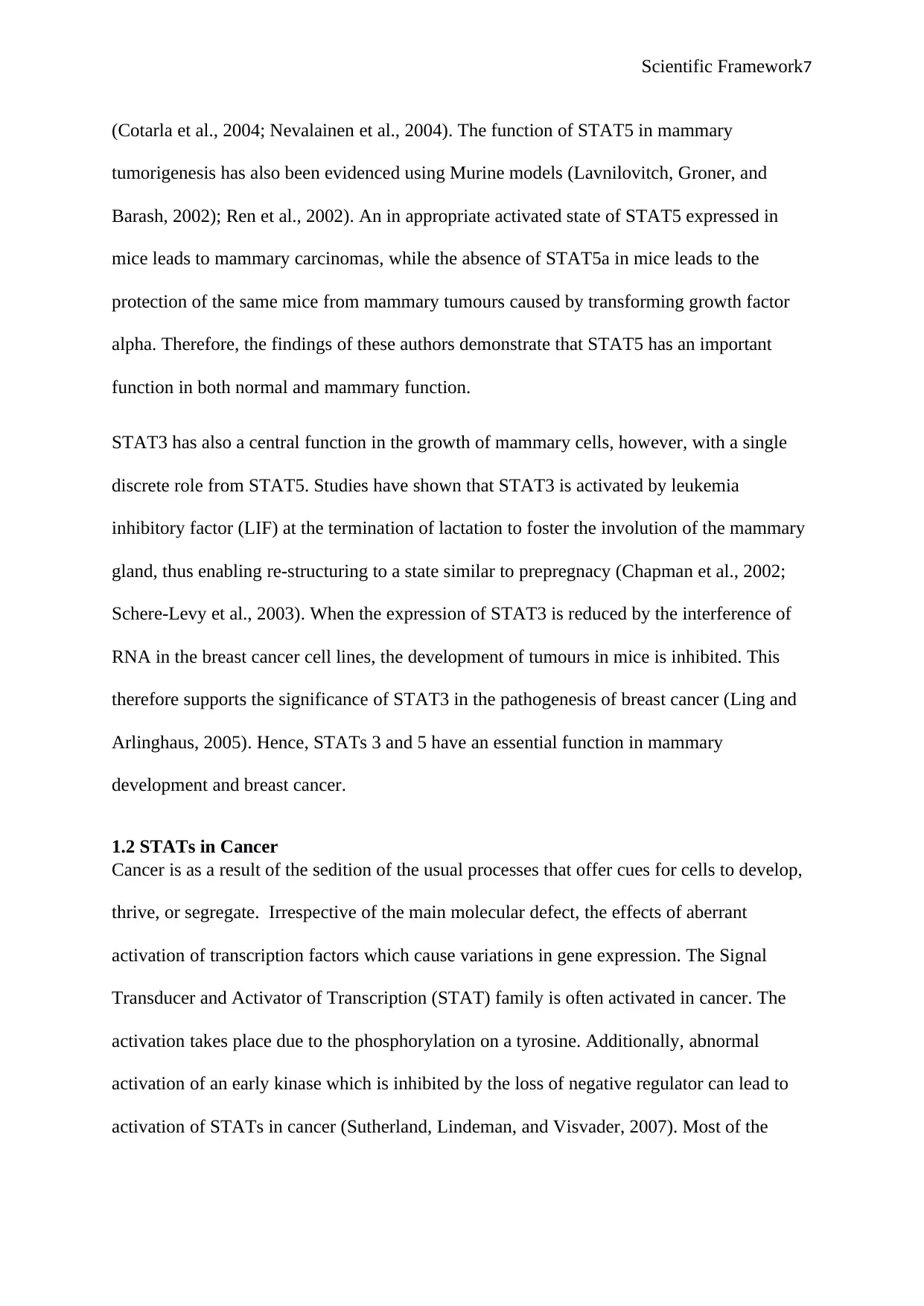
Scientific Framework7
(Cotarla et al., 2004; Nevalainen et al., 2004). The function of STAT5 in mammary
tumorigenesis has also been evidenced using Murine models (Lavnilovitch, Groner, and
Barash, 2002); Ren et al., 2002). An in appropriate activated state of STAT5 expressed in
mice leads to mammary carcinomas, while the absence of STAT5a in mice leads to the
protection of the same mice from mammary tumours caused by transforming growth factor
alpha. Therefore, the findings of these authors demonstrate that STAT5 has an important
function in both normal and mammary function.
STAT3 has also a central function in the growth of mammary cells, however, with a single
discrete role from STAT5. Studies have shown that STAT3 is activated by leukemia
inhibitory factor (LIF) at the termination of lactation to foster the involution of the mammary
gland, thus enabling re-structuring to a state similar to prepregnacy (Chapman et al., 2002;
Schere-Levy et al., 2003). When the expression of STAT3 is reduced by the interference of
RNA in the breast cancer cell lines, the development of tumours in mice is inhibited. This
therefore supports the significance of STAT3 in the pathogenesis of breast cancer (Ling and
Arlinghaus, 2005). Hence, STATs 3 and 5 have an essential function in mammary
development and breast cancer.
1.2 STATs in Cancer
Cancer is as a result of the sedition of the usual processes that offer cues for cells to develop,
thrive, or segregate. Irrespective of the main molecular defect, the effects of aberrant
activation of transcription factors which cause variations in gene expression. The Signal
Transducer and Activator of Transcription (STAT) family is often activated in cancer. The
activation takes place due to the phosphorylation on a tyrosine. Additionally, abnormal
activation of an early kinase which is inhibited by the loss of negative regulator can lead to
activation of STATs in cancer (Sutherland, Lindeman, and Visvader, 2007). Most of the
(Cotarla et al., 2004; Nevalainen et al., 2004). The function of STAT5 in mammary
tumorigenesis has also been evidenced using Murine models (Lavnilovitch, Groner, and
Barash, 2002); Ren et al., 2002). An in appropriate activated state of STAT5 expressed in
mice leads to mammary carcinomas, while the absence of STAT5a in mice leads to the
protection of the same mice from mammary tumours caused by transforming growth factor
alpha. Therefore, the findings of these authors demonstrate that STAT5 has an important
function in both normal and mammary function.
STAT3 has also a central function in the growth of mammary cells, however, with a single
discrete role from STAT5. Studies have shown that STAT3 is activated by leukemia
inhibitory factor (LIF) at the termination of lactation to foster the involution of the mammary
gland, thus enabling re-structuring to a state similar to prepregnacy (Chapman et al., 2002;
Schere-Levy et al., 2003). When the expression of STAT3 is reduced by the interference of
RNA in the breast cancer cell lines, the development of tumours in mice is inhibited. This
therefore supports the significance of STAT3 in the pathogenesis of breast cancer (Ling and
Arlinghaus, 2005). Hence, STATs 3 and 5 have an essential function in mammary
development and breast cancer.
1.2 STATs in Cancer
Cancer is as a result of the sedition of the usual processes that offer cues for cells to develop,
thrive, or segregate. Irrespective of the main molecular defect, the effects of aberrant
activation of transcription factors which cause variations in gene expression. The Signal
Transducer and Activator of Transcription (STAT) family is often activated in cancer. The
activation takes place due to the phosphorylation on a tyrosine. Additionally, abnormal
activation of an early kinase which is inhibited by the loss of negative regulator can lead to
activation of STATs in cancer (Sutherland, Lindeman, and Visvader, 2007). Most of the
Paraphrase This Document
Need a fresh take? Get an instant paraphrase of this document with our AI Paraphraser

Scientific Framework8
upstream kinases can activate STATs, however, the frequent one is the Jak family of kinases,
which interrelate with different cell surface receptors.
1.3 STAT3 in Breast Cancer
STAT3 is activated by 70% in breast tumour constitutively, this is due to STAT3 in cancer
being oncogenic and it is also recognized in all stages of breast cancer. Recent studies show
that STAT3 found in mitochondria promotes the survival of breast cancer cells when it’s
phosphorylated, only due to the effect of mitochondria function (Gough et al., 2009).
1.4 STAT5 in Breast Cancer
STAT5 expresses itself in the form of STAT5a and STAT5b, but due to the overlap of their
roles, they are classified together as STAT5. Wakao, Gouilleux, and Groner (1994) found out
that STAT5 fostered terminal differentiation and survival to the cell. It is also activated in the
mammary gland by prolactin in cytokine, and this takes place during the last stages of
pregnancy through lactation. Tweardy and Chang (2011) found out that STAT5 and prolactin
to be strong barriers to the invasion and expression of cancer cell once it is activated in
mesenchyal.
1.5 Co-activation of STAT5 and STAT3 in Breast Cancer
STAT3 and STAT5 are generally related i.e. both possess different and divergent functions in
normal mammary development. Consequently, STAT5 and STAT3 have similar and
divergent functions in breast cancer (Wakao, Gouilleux, and Groner, 1994).
2.0 Method
Several tests were carried out to show the effectiveness of both transcription factors in breast
cancer such as immunohistochemistry, gene expression array analysis, immunoblots, viability
assay, among others. The examination of STAT3 in breast cancer was tested using breast
cancer cell lines in which a panel of fourteen breast cancer cell lines were used.
upstream kinases can activate STATs, however, the frequent one is the Jak family of kinases,
which interrelate with different cell surface receptors.
1.3 STAT3 in Breast Cancer
STAT3 is activated by 70% in breast tumour constitutively, this is due to STAT3 in cancer
being oncogenic and it is also recognized in all stages of breast cancer. Recent studies show
that STAT3 found in mitochondria promotes the survival of breast cancer cells when it’s
phosphorylated, only due to the effect of mitochondria function (Gough et al., 2009).
1.4 STAT5 in Breast Cancer
STAT5 expresses itself in the form of STAT5a and STAT5b, but due to the overlap of their
roles, they are classified together as STAT5. Wakao, Gouilleux, and Groner (1994) found out
that STAT5 fostered terminal differentiation and survival to the cell. It is also activated in the
mammary gland by prolactin in cytokine, and this takes place during the last stages of
pregnancy through lactation. Tweardy and Chang (2011) found out that STAT5 and prolactin
to be strong barriers to the invasion and expression of cancer cell once it is activated in
mesenchyal.
1.5 Co-activation of STAT5 and STAT3 in Breast Cancer
STAT3 and STAT5 are generally related i.e. both possess different and divergent functions in
normal mammary development. Consequently, STAT5 and STAT3 have similar and
divergent functions in breast cancer (Wakao, Gouilleux, and Groner, 1994).
2.0 Method
Several tests were carried out to show the effectiveness of both transcription factors in breast
cancer such as immunohistochemistry, gene expression array analysis, immunoblots, viability
assay, among others. The examination of STAT3 in breast cancer was tested using breast
cancer cell lines in which a panel of fourteen breast cancer cell lines were used.
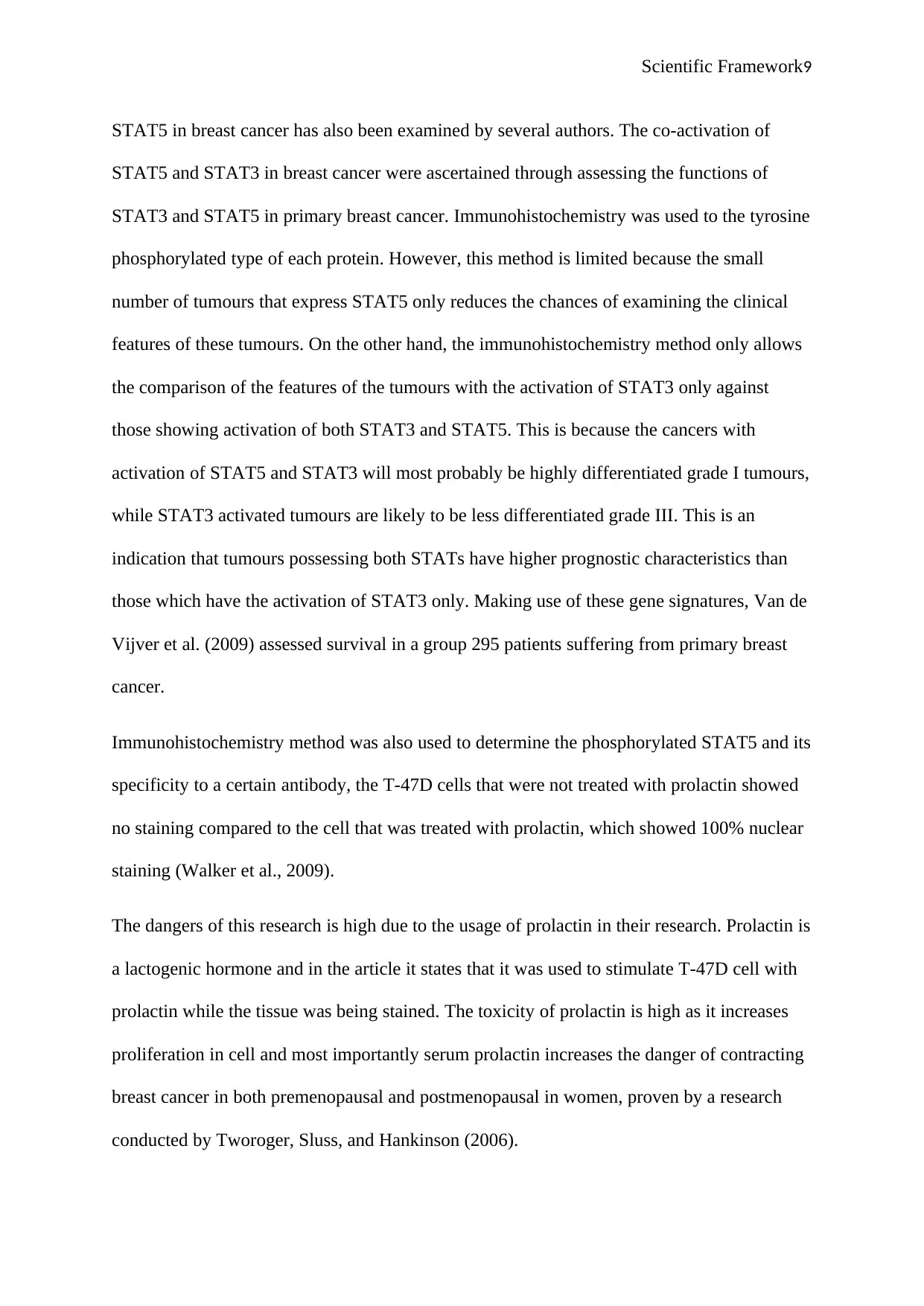
Scientific Framework9
STAT5 in breast cancer has also been examined by several authors. The co-activation of
STAT5 and STAT3 in breast cancer were ascertained through assessing the functions of
STAT3 and STAT5 in primary breast cancer. Immunohistochemistry was used to the tyrosine
phosphorylated type of each protein. However, this method is limited because the small
number of tumours that express STAT5 only reduces the chances of examining the clinical
features of these tumours. On the other hand, the immunohistochemistry method only allows
the comparison of the features of the tumours with the activation of STAT3 only against
those showing activation of both STAT3 and STAT5. This is because the cancers with
activation of STAT5 and STAT3 will most probably be highly differentiated grade I tumours,
while STAT3 activated tumours are likely to be less differentiated grade III. This is an
indication that tumours possessing both STATs have higher prognostic characteristics than
those which have the activation of STAT3 only. Making use of these gene signatures, Van de
Vijver et al. (2009) assessed survival in a group 295 patients suffering from primary breast
cancer.
Immunohistochemistry method was also used to determine the phosphorylated STAT5 and its
specificity to a certain antibody, the T-47D cells that were not treated with prolactin showed
no staining compared to the cell that was treated with prolactin, which showed 100% nuclear
staining (Walker et al., 2009).
The dangers of this research is high due to the usage of prolactin in their research. Prolactin is
a lactogenic hormone and in the article it states that it was used to stimulate T-47D cell with
prolactin while the tissue was being stained. The toxicity of prolactin is high as it increases
proliferation in cell and most importantly serum prolactin increases the danger of contracting
breast cancer in both premenopausal and postmenopausal in women, proven by a research
conducted by Tworoger, Sluss, and Hankinson (2006).
STAT5 in breast cancer has also been examined by several authors. The co-activation of
STAT5 and STAT3 in breast cancer were ascertained through assessing the functions of
STAT3 and STAT5 in primary breast cancer. Immunohistochemistry was used to the tyrosine
phosphorylated type of each protein. However, this method is limited because the small
number of tumours that express STAT5 only reduces the chances of examining the clinical
features of these tumours. On the other hand, the immunohistochemistry method only allows
the comparison of the features of the tumours with the activation of STAT3 only against
those showing activation of both STAT3 and STAT5. This is because the cancers with
activation of STAT5 and STAT3 will most probably be highly differentiated grade I tumours,
while STAT3 activated tumours are likely to be less differentiated grade III. This is an
indication that tumours possessing both STATs have higher prognostic characteristics than
those which have the activation of STAT3 only. Making use of these gene signatures, Van de
Vijver et al. (2009) assessed survival in a group 295 patients suffering from primary breast
cancer.
Immunohistochemistry method was also used to determine the phosphorylated STAT5 and its
specificity to a certain antibody, the T-47D cells that were not treated with prolactin showed
no staining compared to the cell that was treated with prolactin, which showed 100% nuclear
staining (Walker et al., 2009).
The dangers of this research is high due to the usage of prolactin in their research. Prolactin is
a lactogenic hormone and in the article it states that it was used to stimulate T-47D cell with
prolactin while the tissue was being stained. The toxicity of prolactin is high as it increases
proliferation in cell and most importantly serum prolactin increases the danger of contracting
breast cancer in both premenopausal and postmenopausal in women, proven by a research
conducted by Tworoger, Sluss, and Hankinson (2006).
⊘ This is a preview!⊘
Do you want full access?
Subscribe today to unlock all pages.

Trusted by 1+ million students worldwide

Scientific Framework10
The specificity and reproducibility was tested by using immunohistochemistry as the
antibody (phosphor-STAT5) could detect phosphorylated STAT5. Then a breast cancer tissue
was stained using microarray. The antibody used was specific to phosphorylated STAT5 and
STAT3 then the nuclear staining was analysed (Walker et al., 2009). Additionally, the
activation of STAT3 can be improved by using STAT5 activation in breast cancer, as it
moderates the effect of STAT3 (Walker et al., 2009). The article deliberates the possibility
that STAT5 activation modified gene expression in human tumours.
The side effect of STAT3 once it’s activated is that it can lead to resistance to radiation and
chemotherapy due to up regulation of pro-survival gene (Gritsko et al., 2006). Hence the
reason why it cannot be treated alone in breast cancer as it needs co-activation with STAT5 to
reduce the side effect, as it can affect the cell that consists of constitutively active STAT3 to
chemotherapeutic agents.
Lavnilovitch, Groner, and Barash (2002) carried out a study using mice to show that
overexpression and forced activation of STAT5 in mammary gland increases cellular
proliferation, promotes differentiation, and slows apoptosis. The authors argue that signal
transducer and activator of transcription 5(STAT5) has both positive and negative effect in
murine models, the side effect is, STAT5 has proven to enhance mammary tumour in mice,
and it can also increase the development of mammary carcinoma in mice that show
constitutively activation of STAT5. The significant effect of STAT5 is the loss of the
transcription factor (STAT5), which can delay tumour formation (Lavnilovitch, Groner, and
Barash, 2002). Furthermore, mice that have deficiency in STAT5a are safe from mammary
tumours that are induced by altering growth factor alpha. Ultimately STAT5 is the key factor
in both normal and neoplastic mammary function.
The specificity and reproducibility was tested by using immunohistochemistry as the
antibody (phosphor-STAT5) could detect phosphorylated STAT5. Then a breast cancer tissue
was stained using microarray. The antibody used was specific to phosphorylated STAT5 and
STAT3 then the nuclear staining was analysed (Walker et al., 2009). Additionally, the
activation of STAT3 can be improved by using STAT5 activation in breast cancer, as it
moderates the effect of STAT3 (Walker et al., 2009). The article deliberates the possibility
that STAT5 activation modified gene expression in human tumours.
The side effect of STAT3 once it’s activated is that it can lead to resistance to radiation and
chemotherapy due to up regulation of pro-survival gene (Gritsko et al., 2006). Hence the
reason why it cannot be treated alone in breast cancer as it needs co-activation with STAT5 to
reduce the side effect, as it can affect the cell that consists of constitutively active STAT3 to
chemotherapeutic agents.
Lavnilovitch, Groner, and Barash (2002) carried out a study using mice to show that
overexpression and forced activation of STAT5 in mammary gland increases cellular
proliferation, promotes differentiation, and slows apoptosis. The authors argue that signal
transducer and activator of transcription 5(STAT5) has both positive and negative effect in
murine models, the side effect is, STAT5 has proven to enhance mammary tumour in mice,
and it can also increase the development of mammary carcinoma in mice that show
constitutively activation of STAT5. The significant effect of STAT5 is the loss of the
transcription factor (STAT5), which can delay tumour formation (Lavnilovitch, Groner, and
Barash, 2002). Furthermore, mice that have deficiency in STAT5a are safe from mammary
tumours that are induced by altering growth factor alpha. Ultimately STAT5 is the key factor
in both normal and neoplastic mammary function.
Paraphrase This Document
Need a fresh take? Get an instant paraphrase of this document with our AI Paraphraser
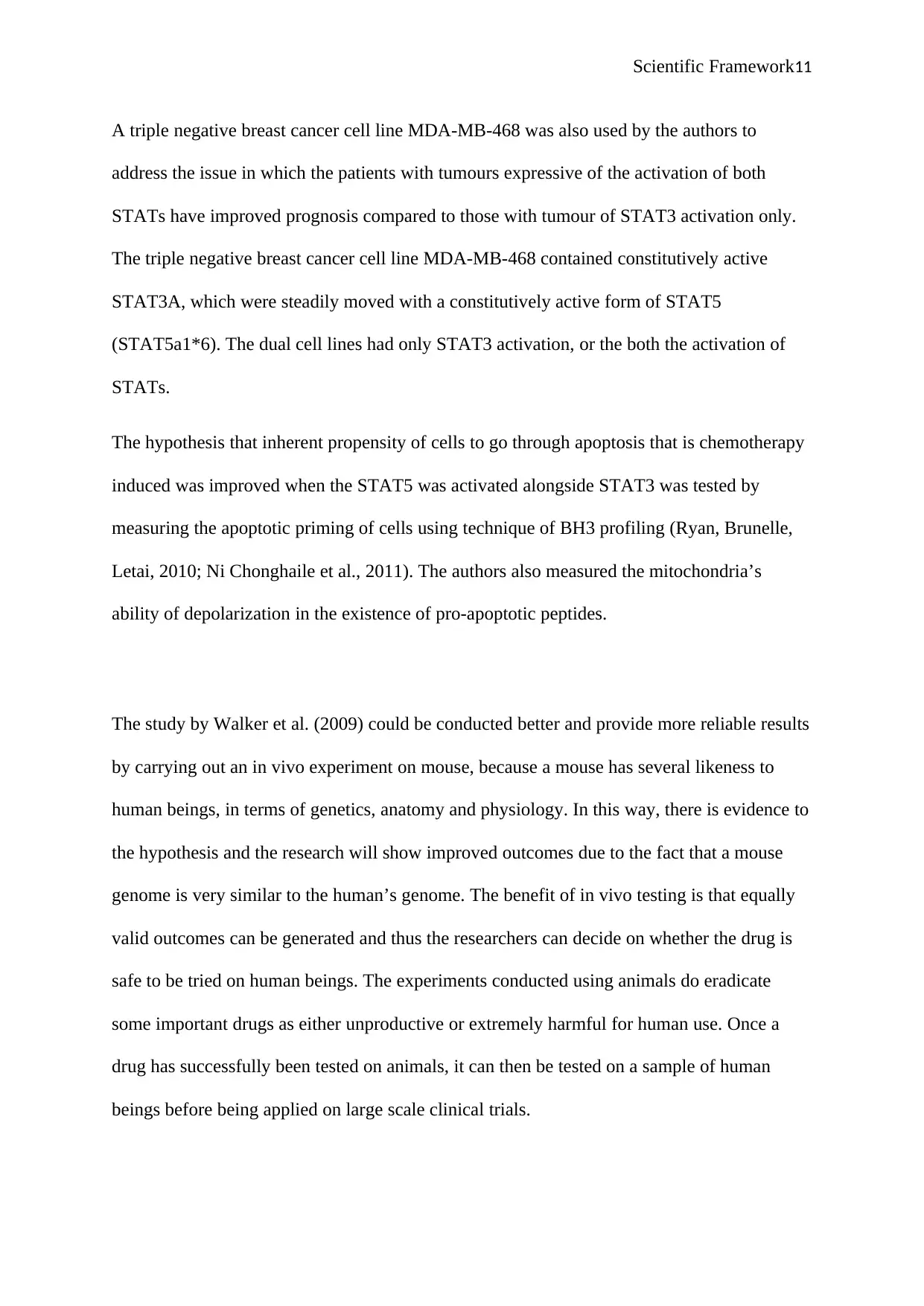
Scientific Framework11
A triple negative breast cancer cell line MDA-MB-468 was also used by the authors to
address the issue in which the patients with tumours expressive of the activation of both
STATs have improved prognosis compared to those with tumour of STAT3 activation only.
The triple negative breast cancer cell line MDA-MB-468 contained constitutively active
STAT3A, which were steadily moved with a constitutively active form of STAT5
(STAT5a1*6). The dual cell lines had only STAT3 activation, or the both the activation of
STATs.
The hypothesis that inherent propensity of cells to go through apoptosis that is chemotherapy
induced was improved when the STAT5 was activated alongside STAT3 was tested by
measuring the apoptotic priming of cells using technique of BH3 profiling (Ryan, Brunelle,
Letai, 2010; Ni Chonghaile et al., 2011). The authors also measured the mitochondria’s
ability of depolarization in the existence of pro-apoptotic peptides.
The study by Walker et al. (2009) could be conducted better and provide more reliable results
by carrying out an in vivo experiment on mouse, because a mouse has several likeness to
human beings, in terms of genetics, anatomy and physiology. In this way, there is evidence to
the hypothesis and the research will show improved outcomes due to the fact that a mouse
genome is very similar to the human’s genome. The benefit of in vivo testing is that equally
valid outcomes can be generated and thus the researchers can decide on whether the drug is
safe to be tried on human beings. The experiments conducted using animals do eradicate
some important drugs as either unproductive or extremely harmful for human use. Once a
drug has successfully been tested on animals, it can then be tested on a sample of human
beings before being applied on large scale clinical trials.
A triple negative breast cancer cell line MDA-MB-468 was also used by the authors to
address the issue in which the patients with tumours expressive of the activation of both
STATs have improved prognosis compared to those with tumour of STAT3 activation only.
The triple negative breast cancer cell line MDA-MB-468 contained constitutively active
STAT3A, which were steadily moved with a constitutively active form of STAT5
(STAT5a1*6). The dual cell lines had only STAT3 activation, or the both the activation of
STATs.
The hypothesis that inherent propensity of cells to go through apoptosis that is chemotherapy
induced was improved when the STAT5 was activated alongside STAT3 was tested by
measuring the apoptotic priming of cells using technique of BH3 profiling (Ryan, Brunelle,
Letai, 2010; Ni Chonghaile et al., 2011). The authors also measured the mitochondria’s
ability of depolarization in the existence of pro-apoptotic peptides.
The study by Walker et al. (2009) could be conducted better and provide more reliable results
by carrying out an in vivo experiment on mouse, because a mouse has several likeness to
human beings, in terms of genetics, anatomy and physiology. In this way, there is evidence to
the hypothesis and the research will show improved outcomes due to the fact that a mouse
genome is very similar to the human’s genome. The benefit of in vivo testing is that equally
valid outcomes can be generated and thus the researchers can decide on whether the drug is
safe to be tried on human beings. The experiments conducted using animals do eradicate
some important drugs as either unproductive or extremely harmful for human use. Once a
drug has successfully been tested on animals, it can then be tested on a sample of human
beings before being applied on large scale clinical trials.
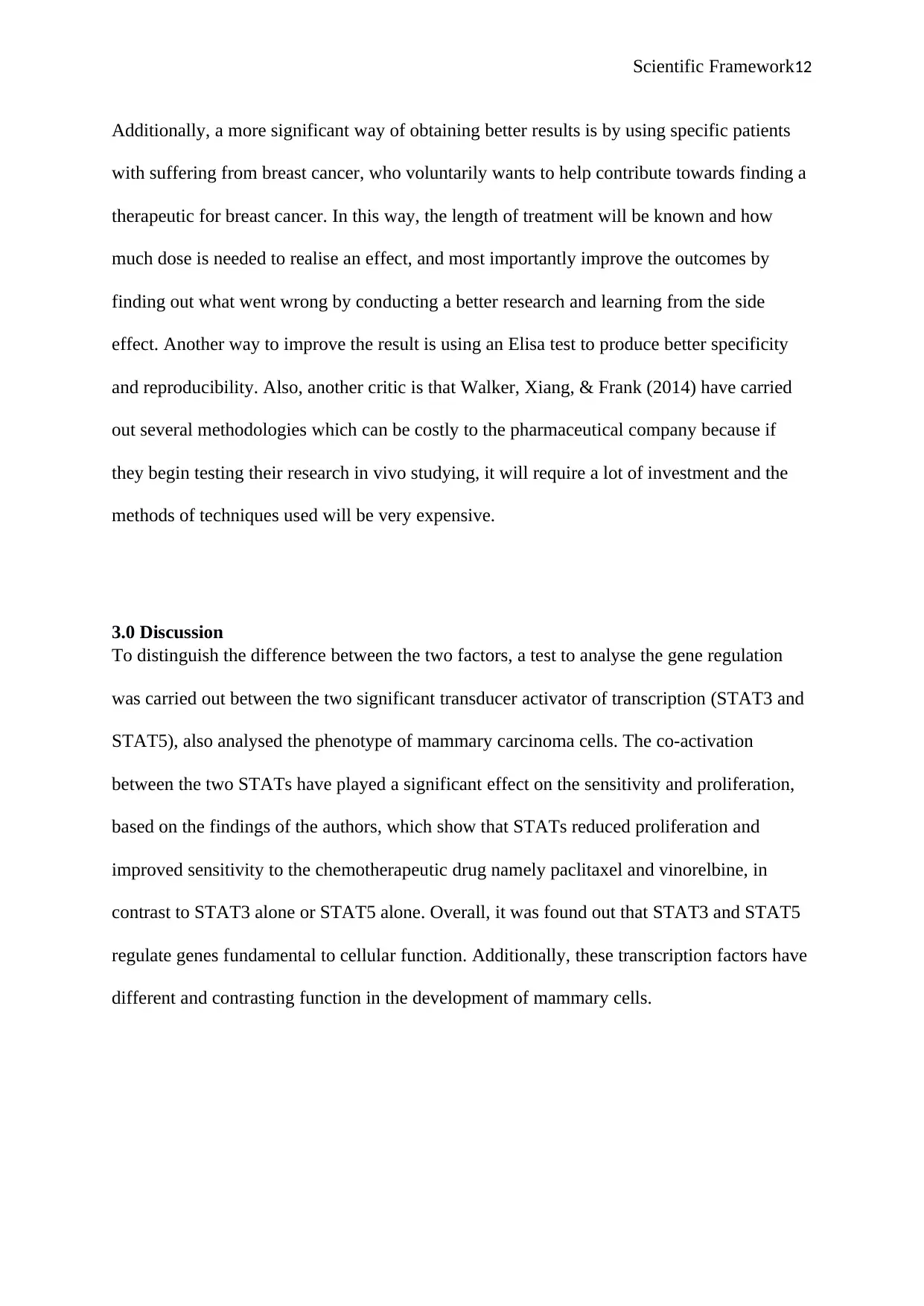
Scientific Framework12
Additionally, a more significant way of obtaining better results is by using specific patients
with suffering from breast cancer, who voluntarily wants to help contribute towards finding a
therapeutic for breast cancer. In this way, the length of treatment will be known and how
much dose is needed to realise an effect, and most importantly improve the outcomes by
finding out what went wrong by conducting a better research and learning from the side
effect. Another way to improve the result is using an Elisa test to produce better specificity
and reproducibility. Also, another critic is that Walker, Xiang, & Frank (2014) have carried
out several methodologies which can be costly to the pharmaceutical company because if
they begin testing their research in vivo studying, it will require a lot of investment and the
methods of techniques used will be very expensive.
3.0 Discussion
To distinguish the difference between the two factors, a test to analyse the gene regulation
was carried out between the two significant transducer activator of transcription (STAT3 and
STAT5), also analysed the phenotype of mammary carcinoma cells. The co-activation
between the two STATs have played a significant effect on the sensitivity and proliferation,
based on the findings of the authors, which show that STATs reduced proliferation and
improved sensitivity to the chemotherapeutic drug namely paclitaxel and vinorelbine, in
contrast to STAT3 alone or STAT5 alone. Overall, it was found out that STAT3 and STAT5
regulate genes fundamental to cellular function. Additionally, these transcription factors have
different and contrasting function in the development of mammary cells.
Additionally, a more significant way of obtaining better results is by using specific patients
with suffering from breast cancer, who voluntarily wants to help contribute towards finding a
therapeutic for breast cancer. In this way, the length of treatment will be known and how
much dose is needed to realise an effect, and most importantly improve the outcomes by
finding out what went wrong by conducting a better research and learning from the side
effect. Another way to improve the result is using an Elisa test to produce better specificity
and reproducibility. Also, another critic is that Walker, Xiang, & Frank (2014) have carried
out several methodologies which can be costly to the pharmaceutical company because if
they begin testing their research in vivo studying, it will require a lot of investment and the
methods of techniques used will be very expensive.
3.0 Discussion
To distinguish the difference between the two factors, a test to analyse the gene regulation
was carried out between the two significant transducer activator of transcription (STAT3 and
STAT5), also analysed the phenotype of mammary carcinoma cells. The co-activation
between the two STATs have played a significant effect on the sensitivity and proliferation,
based on the findings of the authors, which show that STATs reduced proliferation and
improved sensitivity to the chemotherapeutic drug namely paclitaxel and vinorelbine, in
contrast to STAT3 alone or STAT5 alone. Overall, it was found out that STAT3 and STAT5
regulate genes fundamental to cellular function. Additionally, these transcription factors have
different and contrasting function in the development of mammary cells.
⊘ This is a preview!⊘
Do you want full access?
Subscribe today to unlock all pages.

Trusted by 1+ million students worldwide
1 out of 16
Related Documents
Your All-in-One AI-Powered Toolkit for Academic Success.
+13062052269
info@desklib.com
Available 24*7 on WhatsApp / Email
![[object Object]](/_next/static/media/star-bottom.7253800d.svg)
Unlock your academic potential
Copyright © 2020–2025 A2Z Services. All Rights Reserved. Developed and managed by ZUCOL.





